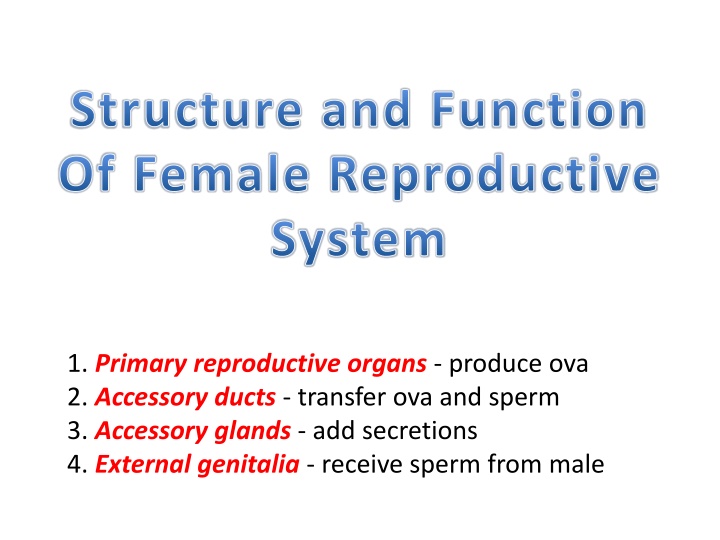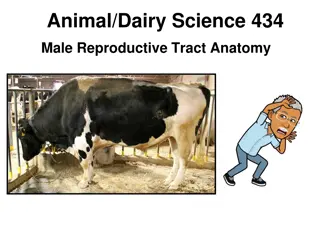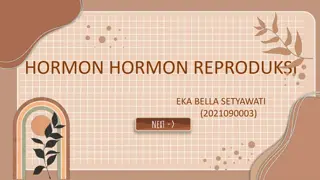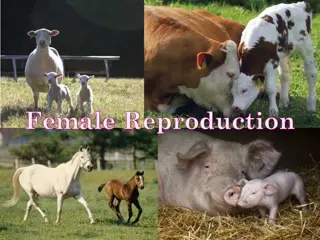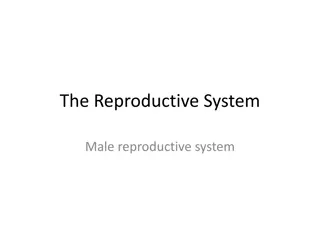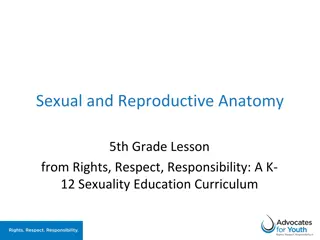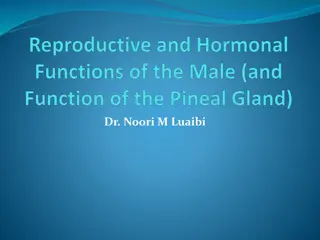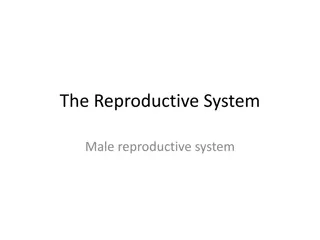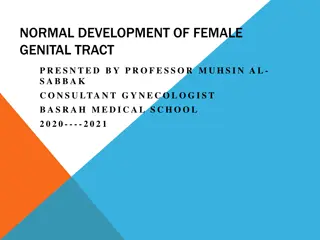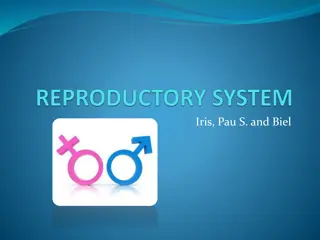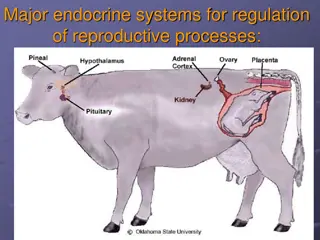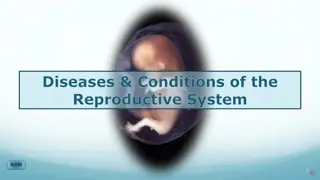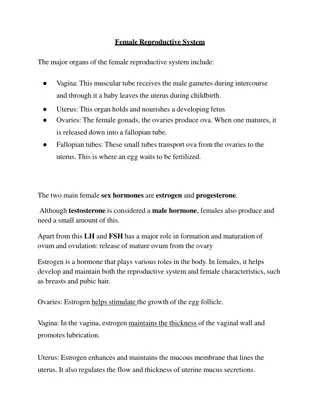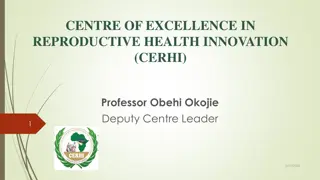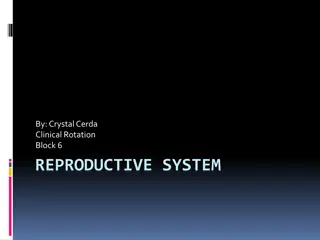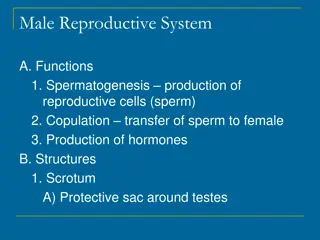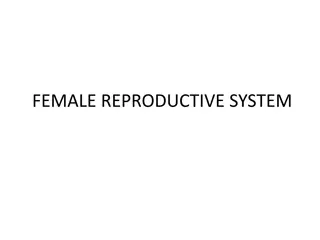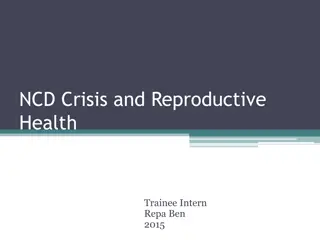Female Reproductive System: Structure and Functions
The female reproductive system consists of primary reproductive organs, accessory ducts, accessory glands, and external genitalia. It includes the ovaries, fallopian tubes, uterus, cervix, vagina, and clitoris, each serving specific functions in reproduction. Hormones play a crucial role in regulating the female cycles, including the ovarian and menstrual cycles, controlled by the anterior pituitary and ovaries. Understanding the structure and function of each component is essential for comprehending female reproductive physiology.
Download Presentation

Please find below an Image/Link to download the presentation.
The content on the website is provided AS IS for your information and personal use only. It may not be sold, licensed, or shared on other websites without obtaining consent from the author.If you encounter any issues during the download, it is possible that the publisher has removed the file from their server.
You are allowed to download the files provided on this website for personal or commercial use, subject to the condition that they are used lawfully. All files are the property of their respective owners.
The content on the website is provided AS IS for your information and personal use only. It may not be sold, licensed, or shared on other websites without obtaining consent from the author.
E N D
Presentation Transcript
Structure and Function Of Female Reproductive System 1. Primary reproductive organs - produce ova 2. Accessory ducts - transfer ova and sperm 3. Accessory glands - add secretions 4. External genitalia - receive sperm from male
(1) The Ovaries - 2 Functions progesterone (from (1) Produce eggs from follicles (2) Produces estrogen (from follicles) & corpus luteum. (2) The fallopian tubes (Oviducts) - connected to uterus & lie close to ovaries - lined with cilia & surrounded by circular muscles - purpose - (1) to propel egg toward uterus (2) to serve as site of fertilization. (3) Uterus (womb) - thick-walled, muscle lining - pear-shaped - lined with a layer called the endometrium - site of development of embryo.
(4) Cervix - entrance to uterus - path for sperm to swim through - produces mucin strands to facilitate sperm - also holds baby in the uterus (5) Vagina - birth canal - receptacle for male s penis (6) Clitoris - sensitive organ analogous to male s penis - responsible for stimulating female orgasm
FEMALE CYCLES AND HORMONE CONTROL 1. Anterior Pituitary - makes 2 hormones that act on the ovaries a) FSH - Follicle Stimulating Hormone - stimulates the follicle to mature and causes it to produce estrogen b) LH - Leutinizing Hormone - maintains the corpus luteum and causes it to produce progesterone 2. Ovary - makes 2 hormones that act on the endometrium (uterus lining) - these are the Gonadotrophic Hormones (FSH & LH) - they regulate the ovary s production of female sex hormones a) Estrogen (made by the follicle) b) Progesterone (made by the corpus luteum)
The Female cycles - there are two cycles -> i) Ovarian cycle ii) Menstrual cycle
i) Ovarian cycle (28 days average) Days 1-13 Folicular Phase -FSH released from ant. pit. - stimulates the development of a follicle (unfertilized egg) - follicle begins to secrete estrogen , so the level of this hormone steadily increased Day 14 this) - Ovulation - follicle releases egg (a peak of LH from ant. pit. stimulates Day 15-28 Luteal Phase - follicle turns into corpus luteum - LH from ant. pit. stimulates the production of progesterone - as progesterone increases, ant. pit. decreased LH so corpus luteum begins to degenerate - when corpus luteum is gone, menstruation occurs
ii) Menstrual Cycle Days 1-5 - low level of estrogen and progesterone - cause thickened uterine lining to degenerate and shed menstruation period Days 6-13 - estrogen (from follicle) is increasing which causes a thickening of the uterus wall (endometrium) - extra blood vessels and glands Day 14 - Ovulation Day 15-28 - increased levels of progesterone causes endometrium to thicken further (2x) and thick mucous secretion - endometrium is ready to receive fertilized egg (zygote)
NORMALLY -> degenerate therefore progesterone falls - low progesterone and estrogen cause endometrium to be shed. Menstruation begins - egg is not fertilized therefore corpus luteum begins to Note: if pregnancy occurs, the zygote imbeds in the thick endometrium and prevents the corpus luteum from degenerating. This keeps up progesterone levels and prevents the endometrium (and zygote from being shed.
OOGENESIS: Development of mature oocytes (eggs)
HOMEWORK 1. Trace the path of sperm through the male reproductive system, including the glands that contribute material to semen. 2. Describe the structure of a testis and give a function for each part. 3. Describe the function of a sperm and give a function for each part. 4. Discuss the relationship between the gonadotrophic hormones (FSH and LH) and the sex hormone testosterone and sperm production. Be sure to mention negative feedback in your discussion. 5. Give the path of the egg. Where does fertilization and implantation occur? 6. Describe the events and hormonal control of the ovarian cycle. 7. Describe the events and hormonal control of the uterine cycle. 8. How is menstruation prevented if pregnancy occurs?
